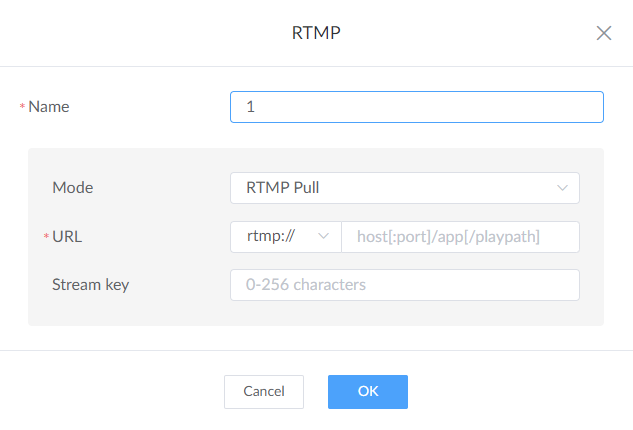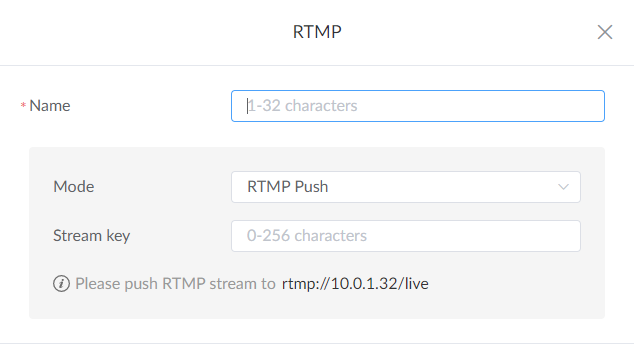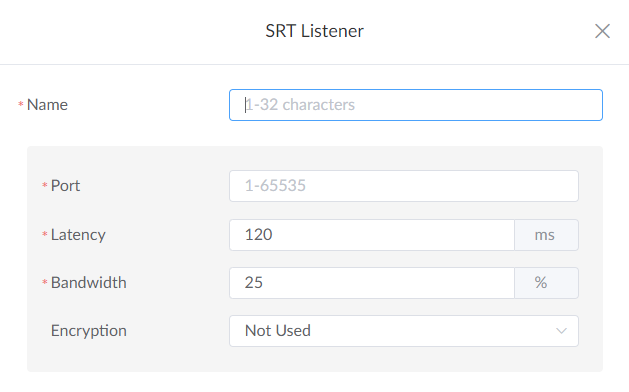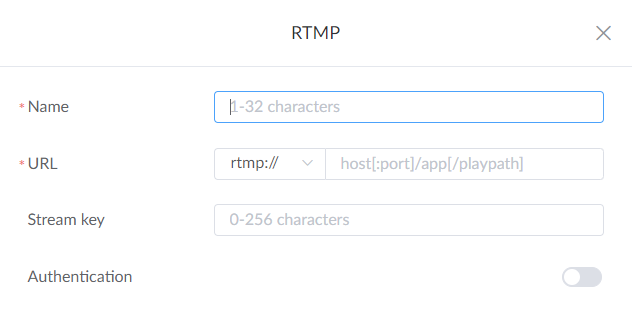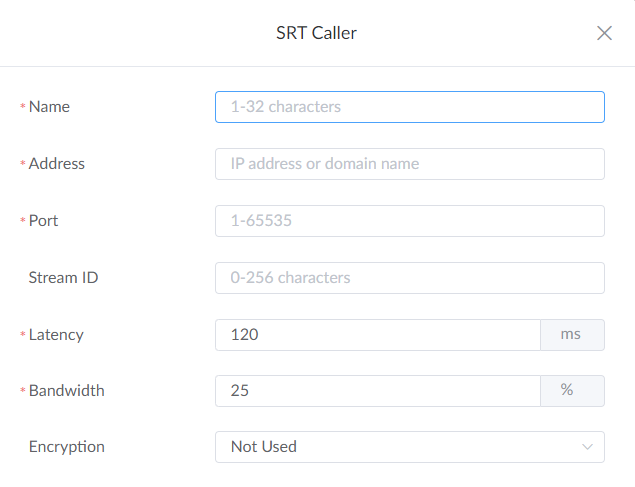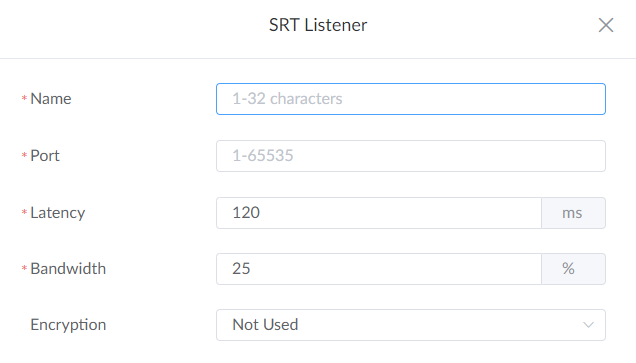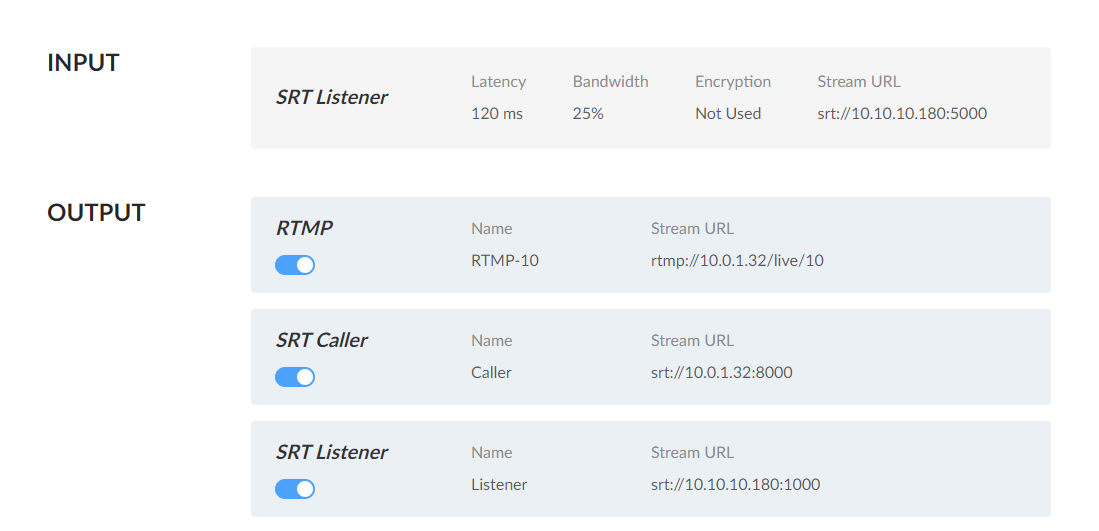- Enter the Stream Conversion page from the navigation pane.
-
Click
 at the upper right,
add input sources, then save your configuration.
at the upper right,
add input sources, then save your configuration.RTMP/RTMPS/SRT Listener sources are now supported.
- Add a RTMP source.
![]()
![]()
Parameters
- Name: specify a name for current task to facilitate server management, which will be displayed in the task list. It is mandatory. Range is 1 to 32 characters except spaces.
- Mode: RTMP Pull, or RTMP Push.
- URL: enter the source URL address. It is mandatory and default as 127.0.0.1. Only available for RTMP Pull mode.
- Stream key: specify input stream key. It is mandatory.
- Add an SRT Listener source.
![]()
Parameters
- Name: specify a name for current task to facilitate server management, which will be displayed in the task list. Range is 1 to 32 characters except spaces.
- Mode: SRT Listener.
- Port: range is 1 to 65535 except 8000. The port number must be unique on the Magewell Cloud. It is mandatory.
- Latency: range is 20 to 8000ms. It is mandatory. Default is 120. We recommend that you set the same latency for SRT pull and push.
- Bandwidth: indicate the portion of the total bandwidth of a stream required for the exchange of SRT control and recovery packets. A worse network condition requires more bandwidth for overhead to ensure normal transmission. It is mandatory. Range is 5 to 100 in Percentage. Default is 25%.
- Encryption: specify the stream encryption algorithm to ensure the data security, options are AES-128/192/256.
- Add a RTMP source.
- Verify input sources.
- Click Rename and input a new task name, then click OK. Range is 1 to 32 characters except spaces.
- Click
 to
modify input, add or modify outputs.
to
modify input, add or modify outputs.
- Click
 to delete current
task.
to delete current
task.
- Click
 to add outputs.
And save after configuration.
to add outputs.
And save after configuration.
Outputs of RTMP/RTMPS/SRT Listener/SRT Caller are supported.
The number of outputs are not limited for each input.
- Add a RTMP output.
![]()
Parameters
- Name: specify a name for current task to facilitate server management, which will be displayed in the task list. Range is 1 to 32 characters except spaces.
- URL: enter the RTMP/RTMPS URL address.
- Stream key: enter the mandatory stream key obtained from the destination.
- Authentication: turn on if your live streaming service provider requires. Enter the Username and Password.
-
Add an SRT Caller/Listener output
![]()
![]()
Parameters
- Name: specify a name for current task to facilitate server management, which will be displayed in the task list. Range is 1 to 32 characters except spaces.
- URL: if the SRT listener and caller are on the same LAN, enter the private IP address of the SRT listener on the LAN. If the SRT listener and caller are in different network environments, enter the public IP address of the SRT listener.
- Port: range is 1 to 65535 except 8000. The port number must be unique on the Magewell Cloud. It is mandatory.
- Stream ID: range is 0 to 256 characters which should be consistent with that of its sender.
- Latency: range is 20 to 8000ms. Default is 120. It is mandatory. We recommend that you set the same latency for SRT pull and push.
- Bandwidth: indicate the portion of the total bandwidth of a stream required for the exchange of SRT control and recovery packets. A worse network condition requires more bandwidth for overhead to ensure normal transmission. It is mandatory. Range is 5 to 100 in Percentage. Default is 25%.
- Encryption: specify the stream encryption algorithm to ensure the data security, options are AES-128/192/256.
- Add a RTMP output.
- Verify outputs.
![]()
- Move the cursor to a task bar, edit and modify input and output.
![]()
![]()
- Click Rename and input a new task name, then click OK. Ranges is 1 to 32 characters except spaces.
- Click
 to edit
output destination.
to edit
output destination. - Click
 to delete
current output.
to delete
current output.
- Start transmuxing: go back to Stream Conversion page, turn on task switch and
start
input streaming. Then you can get outputs in different formats.
The input and output destinations should be pinged. They can be either applications or hardware but do not need to register to Cloud platform.


